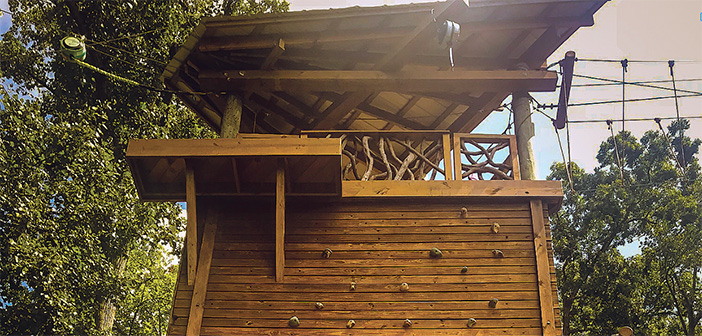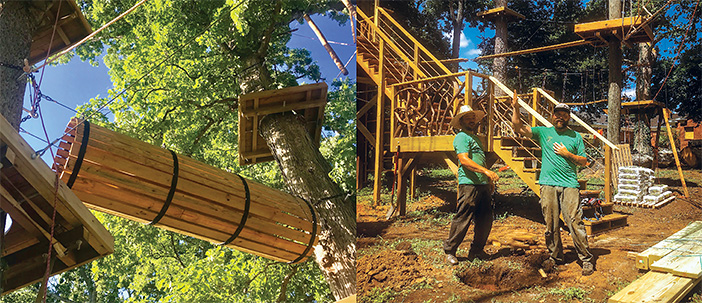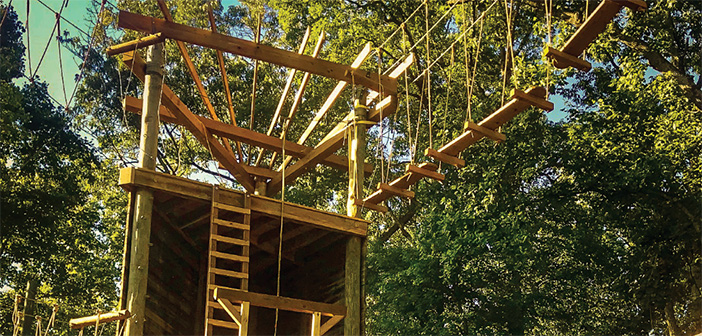Ropes courses and challenge courses have long been used as a tool in adventure-based counseling (ABC). Now, the advent of courses that are thoughtfully built to specifically serve this niche is making ABC a staple among mental health programs. These courses may even have a thing or two to teach experiential and recreational operations more broadly.
The roots of ABC date back to the advent of Outward Bound, which is based on the concept that overcoming intense challenges in a natural setting builds individual confidence and self-worth, as well as a greater awareness of human interdependence as part of a group. ABC, specifically, aims to boost participants’ self-concept by enhancing self-confidence and trust in others—which are especially valuable outcomes for challenged youth.
One great example of an ABC-specific course is at the Crossnore School & Children’s Home foster care facility in Winston-Salem, N.C. Kids can navigate 18 elements, a zip line, free fall, swing, and a four-lane climbing wall, all
designed with ABC in mind.
According to Crossnore counselor Andrew Florence, the idea is to help disadvantaged kids grow, experience, and achieve. “We like to think of them as ‘at-hope’ kids,” says Florence. “The tools they learn through our adventure-based counseling provide them with the hope, confidence, and self-efficacy they need to move forward.”
THE ABCS OF ABC AT CROSSNORE
Crossnore, which has campuses in Hendersonville and Crossnore as well as Winston-Salem, is a mission-oriented residential foster home that provides a safe environment where children can live, learn, and prosper. The school offers a variety of programs to kids ages 1 to 21, including residential group living, community foster care, a young adult transitional program, outpatient mental health services, and day treatment.
A few years ago, as part of its extensive roster of services, Crossnore wanted to integrate adventure-based counseling into its program. A high ropes course, in particular, helps kids face and manage fear, which is useful in retraining their brains on how to face stress—a feeling many of the kids at Crossnore are all too familiar with. The school had an existing high ropes course that had been laying dormant on its Winston-Salem campus, so the framework was already there to do something great.
“Thanks to a generous donor and help from the folks at [North Carolina-based adventure park designer] Beanstalk Builders, we were able to build a completely new ropes course on that same site, using the same towers and surrounding trees,” says Florence.
The extensive course was completed in October 2018, and since then, Crossnore has been putting ABC to work in an atmosphere that’s designed for success. Florence says the potential is limitless. “Our goal is to use the course to promote self-efficacy, self worth, and agency among the children, as well as build a strong team of staffers,” he says.

A child explores balance.
CHALLENGE BY CHOICE
The new course offers myriad learning opportunities. For one, it gives kids in Crossnore’s programs the chance to make their own choices—something they haven’t been able to do much of in their lives. “All of their decisions have been made by others, including caregivers, judges, and social workers,” says Florence. “By providing ABC, our goal is to give them agency to make their own choices.”
To that end, Beanstalk Builders was tasked with a unique installation where choice is part of the equation. Unlike a typical linear design, the Crossnore project enables participants to make a choice at the end of each element—they can continue on to a more challenging element, or turn toward something that’s similar or even easier.
“The ability to move around the course is paramount,” says Isaac Hoff, director of operations at Beanstalk. “We built the Crossnore project with an eye toward progression, and we provide participants with choices at every junction.”
This challenge-by-choice design allows users to determine their own level of comfort, while still providing enough challenge to make them feel successful and empowered.
And while choice is a primary goal, there are other special considerations with this group. One example: suicidal ideation, which Florence says is a concern. To protect kids from reckless behavior, the choice of belay system was extremely important. That led the school to choose the ISC SmartSnap. This smart belay requires 100 percent attachment at all times, as the user can only unlock one connector after the second connector is fully locked in.

A challenge-by-choice design, created by Beanstalk Builders, allows participants to choose activities based on their level of comfort.
EMPOWER, DON’T SCARE
When Florence and Beanstalk came together to design the course, there was a fair bit of discussion on the level of challenge. “We decided that the goal was to empower, not scare, and to focus on accomplishment rather than challenge,” says Hoff.
The end result is a course that still has its challenges, but with emphasis on positive outcomes. Overall, the elements are fairly long from end to end—the shortest is 16 feet, and the longest, 55. The longer elements allow users more time to gain confidence and mastery so that they’re ready to face the next challenge.
There are also standalone elements, such as the climbing lanes, swing, free fall, and zip lines, which allow each participant to complete even a single element and experience some measure of success.

The new ropes course incorporates towers and trees used in a prior build.
FROM THE GROUND UP
The topography of the park also allows for considerable ground involvement, which is one of the keys to the ABC program at Crossnore. Florence describes situations where children are sent through the course while foster parents, therapists, and other caregivers watch and encourage from the ground. This interaction allows children to feel fully supported while having the opportunity to be the masters of their own destiny.
To encourage active ground work, Beanstalk created a sizable deck and gear-up area. This base of operations has a clip-in practice spot and plenty of space for support staff and family. There’s also a small set of stairs before the course where users can again practice the clip-in before they get started.
The design also allows for kids to work together as a group, whether on the ground or in the air. Such peer attachment is important for kids in foster care who may lack a sense of belonging. “Kids have to find new groups to exist within and find their place,” says Florence. “A day on the ropes course accelerates that process as the kids work together toward the same goal.”
To address the fair amount of childhood obesity among kids in the program, Florence says those who exceed the 250-pound weight limit for the course stay on the ground, but are still given important roles. “By getting these kids involved on the ground, we show them that they can play a valuable role toward the collective success of the group,” he adds.

Above left: A non-linear design gives participants choices at every junction. Above right: The ISC SmartSnap system requires 100 percent attachment at all times, which is needed for a high risk clientele.
IT TAKES A VILLAGE
Crossnore has a very small caregiver-to-child ratio, so there are a lot of staff members and adults in general, given that foster and adoptive parents, therapists, and social workers may all be involved. As important as the ropes course is to the children, the challenge course has also become a tool to establish unity among the staff. The staff participates on the ropes course together to encourage communication that goes deeper than a simple “hello” in the hallway.
“Through our course, we’re able to build morale, foster trust, and create effective teams of caretakers,” says Florence. “These types of shared experiences allow our staff to build relationships that are more meaningful.”
This introduction to ABC may help with Florence’s ultimate goal—for the program to progress to a point where all the kids participate with the staff.
Crossnore may also open up the course to outside businesses and groups down the road. The teambuilding opportunities there have been tapped by corporations in the past—the old ropes course at Crossnore was used by the likes of Wells Fargo and Reynolds for just this purpose.

Above left: The goal of these features is to empower, not scare. Above right: Ground space was an important feature to consider, to allow caregivers to watch and encourage from the ground, and have children feel supported while also exploring independence.
THE SKY’S THE LIMIT
While the ropes course at Crossnore has been operational for less than 18 months, Florence anticipates great things for the organization’s ABC program. He already sees transformations in both the staff and the children who go through the ropes course. He points to the experience of two older siblings—a boy and a girl—who, as part of a larger sibling group, really didn’t get a lot of attention.
“We had the mother and the therapist below as the children negotiated some of the elements, but they were encouraged to make their own decisions as they went through,” says Florence. “When the girl came to the zip line, she was terrified. But with perseverance, bravery, agency, and support, she did it. At the bottom she grinned and said, ‘If I can do that, I can do anything.’”
From disenfranchised children to people who are in recovery from substance use disorders, ABC is finding a place in therapeutic programs at Crossnore and across the country.
“The children in our program are brave, strong, vulnerable, resilient, and unique—and we don’t want to change that,” says Florence. “What we do want to accomplish is to lay the groundwork for more self efficacy; to show them they’re capable of more than they may realize.”






